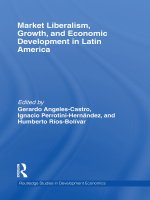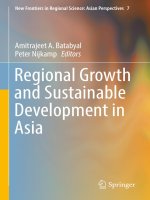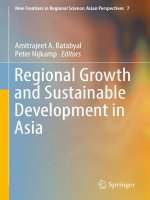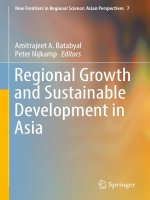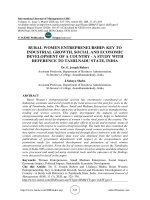Economic growth and economic development 89
Bạn đang xem bản rút gọn của tài liệu. Xem và tải ngay bản đầy đủ của tài liệu tại đây (118.68 KB, 1 trang )
Introduction to Modern Economic Growth
population growth at the rate n) as
A (k )1 =
or
n+
s
à
ả 1
sA 1
k =
,
n+
which is a simple and interpretable expression for the steady-state capital-labor
∗
ratio. k ∗ is increasing in s and A and decreasing in n and δ (which is naturally
consistent with the results in Proposition 2.8). In addition, k∗ is increasing in α.
This is because a higher α implies less diminishing returns to capital, thus a higher
capital-labor ratio reduces the average return to capital to the level necessary for
steady state as given in equation (2.33).
Transitional dynamics are also straightforward in this case. In particular, we
have:
k˙ (t) = sA [k (t)]α − (n + δ) k (t)
with initial condition k (0). To solve this equation, let x (t) ≡ k (t)1−α , so the
equilibrium law of motion of the capital labor ratio can be written in terms of x (t)
as
x˙ (t) = (1 − α) sA − (1 − α) (n + δ) x (t) ,
which is a linear differential equation, with a general solution
∙
¸
sA
sA
x (t) =
+ x (0) −
exp (− (1 − α) (n + δ) t) .
n+δ
n+δ
(see, for example, the Mathematical Appendix, or Boyce and DiPrima, 1977, Simon
and Bloom, 1994). Expressing this solution in terms of the capital-labor ratio
1
á
ắ 1
ẵ
sA
sA
1
+ [k (0)]
exp ( (1 α) (n + δ) t)
−
.
k (t) =
n+δ
δ
This solution illustrates that starting from any k (0), the equilibrium k (t) → k ∗ =
(sA/ (n + δ))1/(1−α) , and in fact, the rate of adjustment is related to (1 − α) (n + δ),
or more specifically, the gap between k (0) and its steady-state value is closed at
the exponential rate (1 − α) (n + δ). This is intuitive: a higher α implies less di-
minishing returns to capital, which slows down the rate at which the marginal and
average product of capital declines as capital accumulates, and this reduces the rate
75
